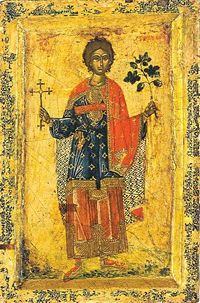Tryphon, Respicius, and Nympha
Saints Tryphon (Trypho), Respicius, and Nympha (Ninfa) are Christian saints who were formerly celebrated jointly on 10 November in the liturgical calendar of the Roman Rite of the Catholic Church from the eleventh century until the twentieth.[1] Saint Tryphon continues to be celebrated (separately) on 1 February on both the Orthodox liturgical calendar and the Roman Calendar of Saints.
| Saints Tryphon, Respicius, and Nympha | |
|---|---|
 Serbian Orthodox icon of St. Tryphon of Campsada. | |
| Martyrs | |
| Born | Kampsade (Tryphon) |
| Died | 250 AD Nicaea (Tryphon) |
| Honored in | Roman Catholic Church; Eastern Orthodox Church |
| Feast | 10 November (former joint feast day in the Roman Catholic Church); 1 February (just Tryphon) in Roman Catholic and Eastern Orthodox calendars |
| Attributes | falcon (Tryphon) |
| Patronage | gardeners and winegrowers (Tryphon); Kotor, Montenegro (Tryphon); Moscow, Russia Tryphon); invoked against rodents and locusts (Tryphon) |
Saint Tryphon edit
Saint Tryphon is said to have been born at Kampsade (Campsada, in Phrygia, now Turkey,[2] and as a boy took care of geese. His name is derived from the Greek τρυφη (tryphe) meaning "softness, delicacy". He acquired fame as a healer, especially of animals, and is considered one of the Holy Unmercenaries, particularly invoked on farms.[3]
During the Decian persecution he was taken to Nicaea about the year 250 and was tortured in a horrible manner. He was beheaded with a sword after he had converted the heathen prefect Licius. Fabulous stories are interwoven with his hagiography.
His relics were first buried in his native city of Campsada. Later on, they were translated to Constantinople, and then to Rome. His feast day is on 1 February in both the Eastern Orthodox Church and (now) in the Roman Catholic Church.[4]
He is greatly venerated in the Eastern Orthodox Church, in which he is also the patron saint of gardeners and winegrowers. Many churches were dedicated to him, and the Eastern Emperor, Leo VI the Wise (d. 912), delivered a eulogy in Tryphon's honour. He is the protector saint of the town of Kotor in Montenegro, and one of the patron saints of Moscow. In Russian icons of the saint, he is often shown holding a falcon, a reference to a miracle attributed to his intercessions. Prayers attributed to him are used against infestations of rodents and locusts; one such prayer appears in the Great Euchologion.[5]
The Cathedral of Saint Tryphon in Kotor is dedicated to him.
Respicius and Nympha edit
The former 10 November feast day associated with Saint Tryphon two others, of whom little is known: Respicius and Nympha.
In about 1005, the monk Theodoric of Fleury wrote, on the basis of earlier written legends, an account of Tryphon in which Respicius appears as Tryphon's companion. The relics of both were preserved, together with those of a holy virgin named Nympha, at the Hospital of the Holy Ghost in Sassia. The church of this hospital was a cardinal's title, which, together with the relics of these saints, was transferred by Pope Pius V to the Church of St. Augustine in 1566.
One tradition held that Nympha (Ninfa) was a virgin martyr from Palermo who was put to death for the faith at the beginning of the fourth century. According to other versions of the legend, when the Goths invaded Sicily, she fled from Palermo to the Italian mainland and died in the sixth century at Savona. The feast of her translation is observed at Palermo on 19 August. Some believe that there were two saints of this name. Before 1624 Palermo had four patron saints, one for each of the four major parts of the city. They were Saint Agatha, Saint Christina, Saint Nympha, and Saint Olivia. Their images are displayed at the Quattro Canti, in the centre of Palermo.
While Saint Trypho is still listed in the Roman Martyrology (on 1 February, not 10 November), Respicius and Nympha have been omitted.
See also edit
- [[Archivo:
- REDIRECCIÓN Plantilla:Iconos|20px|Ver el portal sobre Saints]] Portal:Saints. Contenido relacionado con Saints.
References edit
- ^ Calendarium Romanum (Libreria Editrice Vaticana, 1969), p. 145
- ^
- REDIRECT Template:Cite Catholic Encyclopedia
- ^ Lua error in package.lua at line 80: module 'Module:Citation/CS1/Suggestions' not found.
- ^ Martyrologium Romanum (Libreria Editrice Vaticana, 2001 ISBN 88-209-7210-7)
- ^ Lua error in package.lua at line 80: module 'Module:Citation/CS1/Suggestions' not found.
External links edit
This article incorporates text from a publication now in the public domain: Herbermann, Charles, ed. (1913). . Catholic Encyclopedia. Robert Appleton Company. {{cite encyclopedia}}: Cite has empty unknown parameters: |1=, |month=, and |coauthors= (help); Invalid |ref=harv (help)
bg:Трифон Зарезан fr:Saint Tryphon hr:Sveti Tripun it:San Trifone pl:Tryfon (męczennik)